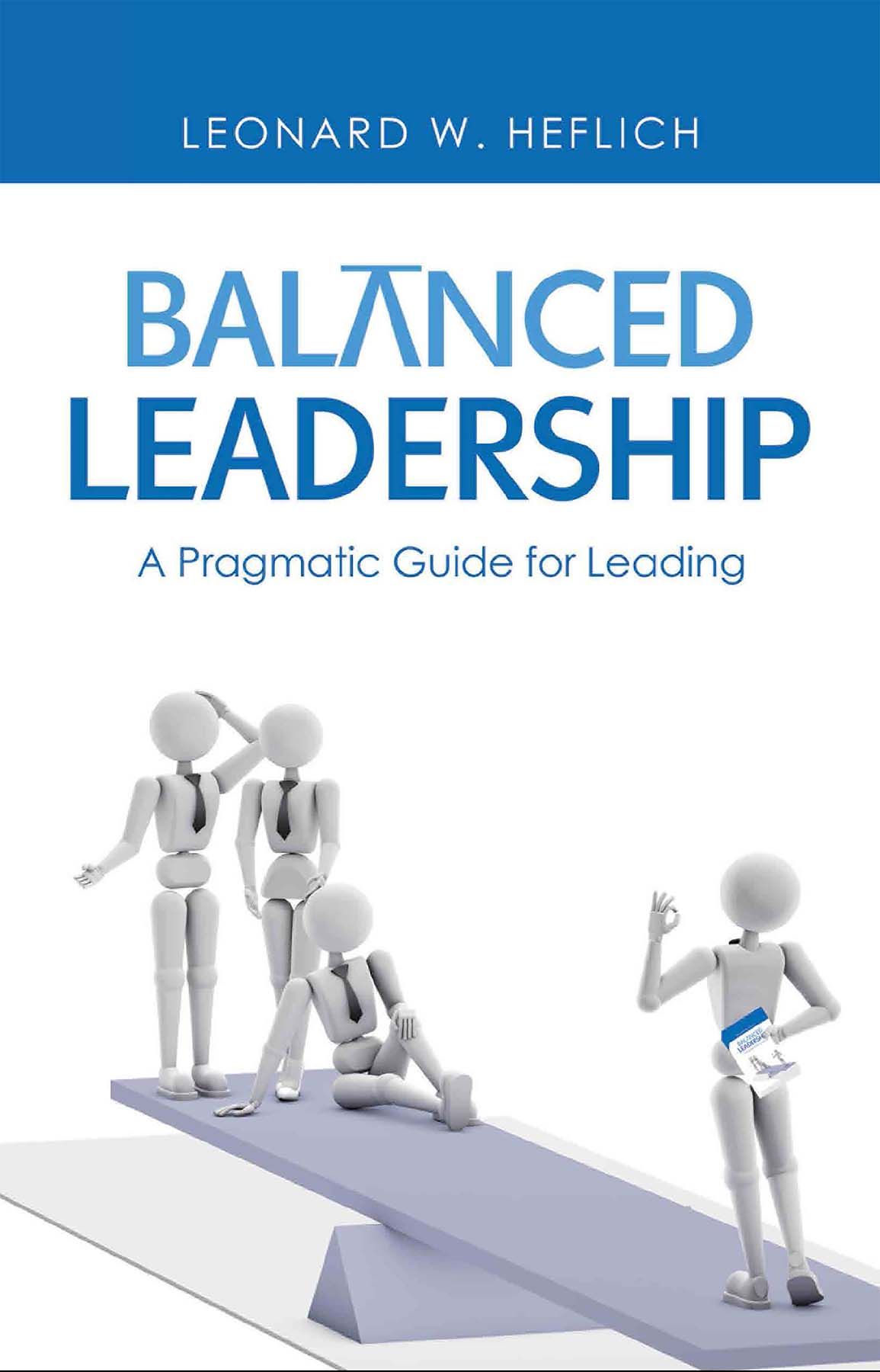EXPLORE
BOOKS
Balanced Leadership:
A Pragmatic Guide for Leading
Are you a new leader?
Are you a veteran leader facing new challenges?
Are you as effective a leader as you want or need to be?
Has the game changed requiring you to adapt or fail?
This book will guide you to become a better leader, maybe even a great one!
We need effective leaders today more than ever before. The root cause behind most failed businesses and failed governments is either a lack of leadership or the presence of destructive or ineffective leadership. In this collection of dissertations on topics relevant to effective leadership, you will be challenged to think. Along the way, you will learn how to discover and clarify your mission, vision, and values; learn how to handle difficult people and situations; improve the performance of your people and teams; and communicate with coworkers, customers, and colleagues. You will also learn about the leadership continuum, its gradations and how to find the action, behavior, or decision that balances as best as possible benefits with costs. Balance is getting something just right. However, since the world is always changing, the sweet spot is always changing too. What was in balance yesterday may not be today. Like riding a bicycle, we constantly need to monitor our positions and make adjustments to compensate for curves and bumps in the road. Make sound decisions, build better teams, communicate more effectively, be appropriately flexible, and be appropriately strong, with the lessons, examples, and insights in Balanced Leadership.
Foreword Reviews
Balanced Leadership carves out a unique position among leadership books.
Leonard Heflich’s Balanced Leadership makes a strong, articulate case for becoming an effective business leader.
As a senior executive with manufacturing experience, Heflich wondered why some plants performed well while others needed serious improvements. He found that “the single defining difference between these facilities [was] the lack of effective leadership.” In a book that is less a prescribed plan for change than it is a cohesive collection of thoughts, Heflich promotes balance as “a singular but critical lens through which to view leadership.”
The book begins with a wide-ranging overview of various leadership qualities, including authenticity, vision, ownership, and flexibility. The distinction it draws between leadership and management is a common one. More intriguing are its discussions of the differences between leadership and “pushership,” defined as “the practice of getting behind people and pushing them in the desired direction.” Using a helpful table to highlight the situations in which leadership and pushership are most appropriate, the book points out that both can be effective when properly balanced; however, with pushership, “subordinates do not develop or grow.” This particular topic is novel and is not often addressed in leadership books.
The notion of balance is also applied to chapters concerning leading yourself, leading others, communication, leadership challenges, and making decisions. In fact, one of the book’s strengths is its broad application of “balance” across many areas. The book is nicely organized into seven substantial chapters, each of which addresses balance in a different context. Chapters are broken into short, readable sections with plenty of bulleted text, the occasional table, and chapter summaries.
Numerous examples of work situations are effectively employed in support of the argument that balance is an essential attribute of effective leaders. The writing style is clear and straightforward, with the book’s direct approach keeping its language informal and still maintaining an authoritative voice. The author’s experience is a definite asset which contributes to depth and quality of the conversation about leadership.
Much of the material sounds familiar, but several of the concepts here stand out and are worthy of serious consideration. They include an insightful perspective on the key differences between being smart and being wise; the ideal, but rare, leader incorporates both qualities, according to the book. Also interesting are the book’s discussion of work teams, including the unique characteristics of men and women and how they both bring balance to a team. Insights like these lift Balanced Leadership above the average leadership textbook.
Given the number of business leadership books available, it is challenging to communicate something new. Leonard Heflich does a fine job carving out a unique position with Balanced Leadership.
BARRY SILVERSTEIN (August 16, 2018)
Disclosure: This article is not an endorsement, but a review. The author of this book provided free copies of the book and paid a small fee to have their book reviewed by a professional reviewer. Foreword Reviews and Clarion Reviews make no guarantee that the author will receive a positive review. Foreword Magazine, Inc. is disclosing this in accordance with the Federal Trade Commission’s 16 CFR, Part 255.
Kirkus Reviews
A debut business leadership book emphasizes balance.
An overabundance of leadership books may evoke a jaundiced reaction from business executives to anything new, but Heflich’s effort is not a throwaway. His theme revolves around the notion that balance, in the broadest sense of the word, makes for effective leadership. The author recognizes the nuances of the word, suggesting: “Balance does not imply compromise or a middle-of-the-road approach....Do you see the importance of balance and the trade-off of cost with benefit involved in each decision? The trade-off is inescapable, and the balance that you choose is defining!” With that premise in mind, the volume addresses balance in somewhat lengthy chapters that are, at least, nicely subdivided into manageable chunks of information. Each chapter concerns balance as it applies to leadership attributes, such as directing others, communicating, facing management challenges, and making decisions. Heflich, whose background is in manufacturing, offers astute observations that apply generally across all forms of business, and they are both well-founded and experience-based. The author draws on other sources, employs good examples, and writes with a keen sense of perspective. The advice he doles out to the individual leader is particularly on-target. The chapter “Balance in Leading Yourself,” while encompassing such traditional components as mission, vision, and values, speaks directly to an executive’s personal qualities. For example, Heflich writes eloquently about emotional intelligence, which he says “is about accepting responsibility for our behaviors.” His view of wisdom is also meaningful. While “smart” people may consider the facts, writes the author, “wise” ones size up “a situation by considering the facts on hand, but in addition, they consider their values and goals.” Other intriguing sections in this particularly engrossing chapter include “Risking Your Job to Save It,” “Adequacy and Inadequacy,” and “Work-Life Balance.” Throughout the well-conceived book, Heflich exudes a quiet competence and calmness, writing from the viewpoint of someone who has critically scrutinized the behaviors of himself and other executives. “The balance you strike,” concludes the author, “defines you as a leader and a person.”
An articulate, passionate, and illuminating work that makes a sound contribution to leadership literature.
Live As Long As Your Dare!
A Journey to Gain Healthy, Vibrant Years
This book can help you to live a longer, healthier life, regardless of your current age. It is never too early to start taking better care of yourself and it is never too late! Age is a number and often a state of mind, neither of which should limit our expectations. Attitude is critical, requiring that we dare to live longer and healthier if we are going to do it. I talk about ways to take care of ourselves in ways we probably haven't considered. I talk about how to develop our capabilities rather than accepting a gradual decline that results in diminished capability, decreased activity and ultimately death. I break it up into little, easy, even fun pieces that we can incorporate into our lifestyle. This is a journey we start now and continue for the rest of our healthy, vibrant lives - for as long as we dare!
Watch to Learn More!
United in Prayer
A Book on Prayer and Praying
We all pray. Prayer is non-denominational and universal. Prayer is comforting and healing. It is an activity that can unite us as people and peoples. We need this today more than ever.
Prayer is seldom considered a skill, but like any activity it can be improved by practice and guidance. Interestingly, the guidance we have received from masters of prayer over the ages is remarkably similar and consistent, regardless of faith or creed.
This book is an optimistic and practical review of prayer. I do not promote the perspective of any religion. I promote prayer. Prayer is for us. Let us pray!
Watch to Learn More!
Useful links
Contact info
Join the Newsletter
Thank you for contacting us here at Innovation for Success, LLC.
We will get back to you as soon as possible
Please try again later




